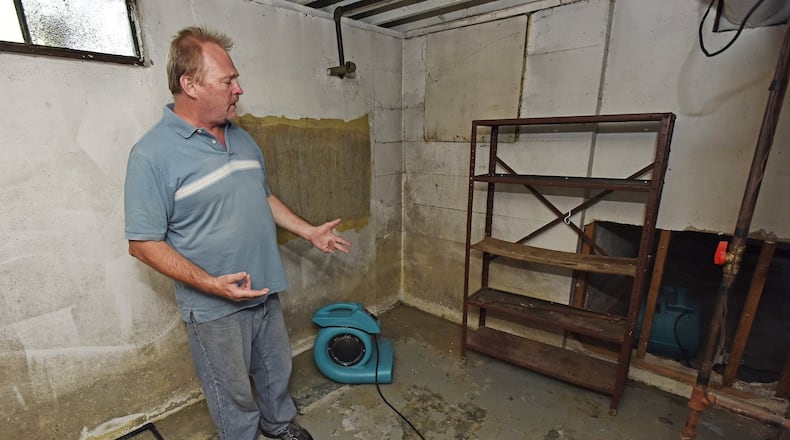“We believe … the $2,500 should cover (the installation), unless there’s some special, unusual circumstance that we’re not aware of,” he said.
Park Avenue resident Sandra Henderson hopes her house will be among those the program can aid. Her home’s flooding, which she believes included some sewage in June — she’s not sure about September — destroyed not only things she and her husband, Kevin, were storing in the basement, but also many of the belongings in June of her college-aged son, Daniel Adams, who was living downstairs.
“We lost a lot,” said Sandra Henderson, who lives near Cereal Avenue, in an area of the Highland Park neighborhood where many were harmed.
“We had a river over here,” she said, pointing to an area near her house, “and then it all came to our basement. My son called me, because he got home before I did, and when I came in, there was over a foot of water. I’m afraid there’s mold down there right now, because we had to get everything out, and couldn’t afford to get anything fixed.”
“Then it got flooded again,” in September, she said.
Floods twice destroyed the finished basement of a friend who lives nearby, she said.
Henderson may be among those the program can help.
“I lost a lot of sleep at first,” she said. “And now I’m like, ‘I don’t want it to happen anymore.’ I want to be able to put stuff down there, and not worry.”
Maynard said during a meeting at Hamilton High School, “We had a form that people could take, and if they were interested in the program, then they sent it in.”
To follow up on that form, city workers have been examining basements to see whether they believe installation of check-valves — which allow fluids only to move away from the buildings — would prevent future flooding. City employees are also gathering information on their visits about other flooding people have experienced.
“If everything looks like it would be a help there, to prevent those problems, then we have an agreement that we ask people to sign, to participate in the program,” Maynard said. “Then we allow them to work with a plumber to get it installed.”
So far, no installations have happened, but Hamilton has been meeting with three plumbing contractors “to maybe get the first five or 10 of them installed, so that we make sure that we’re covering everything that we think needs to be covered in the scope of work,” Maynard said.
For example, the city is asking plumbers to use video equipment to examine the sewer pipes from the home’s floor drains out into the city’s sewer pipes, “to ensure it’s not another problem,” Maynard said. “That’s just part of the due-diligence work, to make sure that if something gets installed there, that it’s going to be effective in solving the problem for people.”
Installations should start within the next week or so, Maynard said. For those like Henderson who have already turned in applications, “they should be hearing from us soon,” he said.
Among those who wouldn’t be helped by the program are those who had water enter their basements through a window or a wall, as opposed to backing up through sanitary sewer pipes, which are meant to convey only sewage.
Henderson hopes a check-valve can help her. “I don’t want my house flooded again,” she said. Henderson said she’s lived in the home six or seven years, and June was the first flooding she experienced.
“I went for flood insurance after this, and what he quoted me blew my mind — it was more than my homeowners’ (insurance),” she said. She said the agent told her she’d be crazy to get flood insurance.
Half the city’s $2,500 reimbursement amount will come from Hamilton’s waste-water fund, which pays for sewage-system issues, with the rest from its storm-water fund, which installs and replaces fixtures that handle rain.
Checks will be written to both the homeowners and plumbers to ensure those owning the properties are satisfied with the work, Maynard said.
In another move to eliminate basement flooding, the city has been performing “smoke” and dye-testing that reveals whether buildings’ storm gutters or sump pumps are improperly connected to the sewage-conveying system, which can greatly overload the sewage system during storms. Crews have found about 30 such buildings.
More dye-testing also is needed to find others, he said. The city hasn’t decided to what extent — if any — it will reimburse property owners for disconnecting buildings from the sewage system.
For many owners, “It may be as simple as the discharge, instead of going into the sanitary sewer, is just piped outside, and it splashes on a block in their backyard,” Maynard said. And the process could be similar for gutter downspouts, he said “It doesn’t in all cases have to be an expensive solution,” Maynard said.
Hamilton Public Works officials, meanwhile, are working on a different set of issues that caused simultaneous street-flooding issues nearby on Main Street and other city roadways.
About the Author
